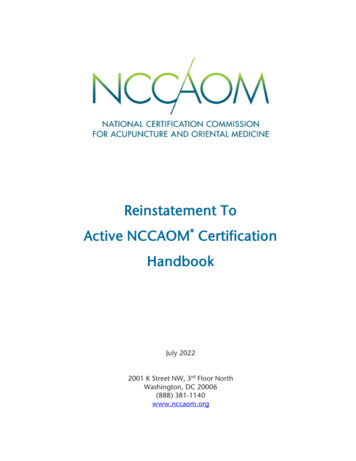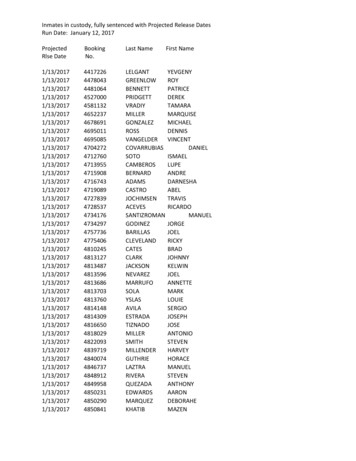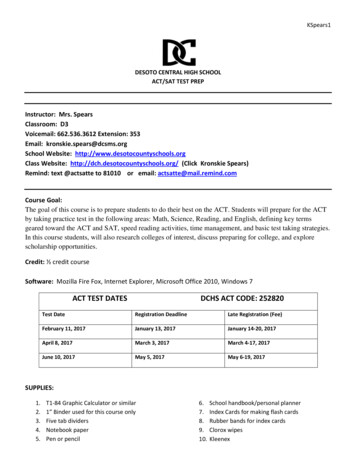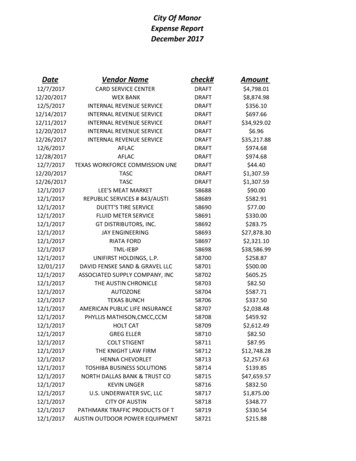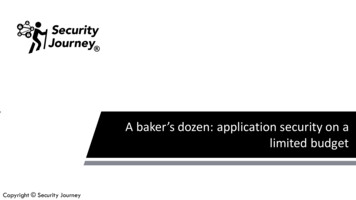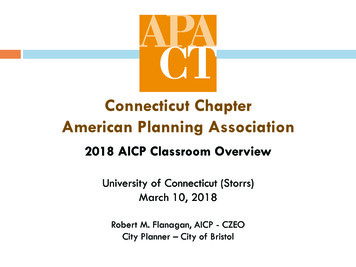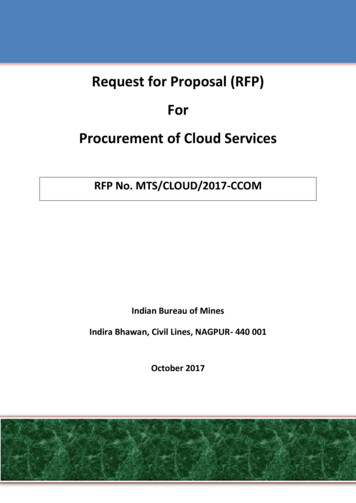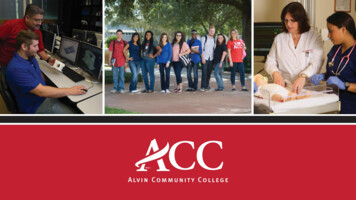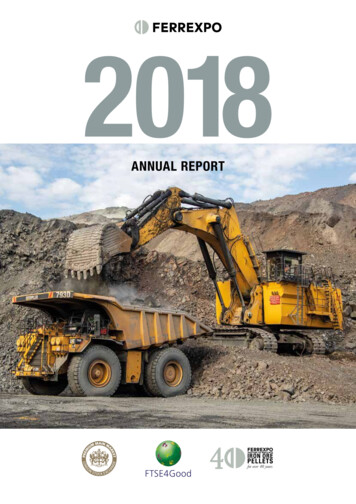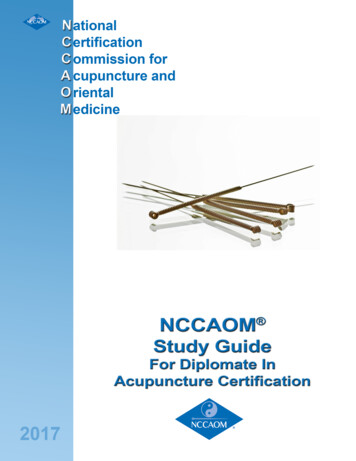
Transcription
2017NCCAOM Examination Study Guide for theDiplomate of Acupuncture CertificationNCCAOM 76 S. Laura Street Suite 1290Jacksonville, FL 32202Phone 904.598.1005 Fax 904.598.5001 2017 NCCAOM
Table of ContentsTHE EXAMINATION PROCESSIntroductionExamination DevelopmentExamination Content ValidationThe NCCAOM Job AnalysisItem WritingItem ReviewExamination Administration23334452017 EXPANDED CONTENT OUTLINESFoundations of Oriental Medicine Content Outline6Biomedicine Content Outline-Appendix A: Pharmaceuticals-Appendix B: Nutrients and Supplements-Appendix C: Clinical Conditions15212223Acupuncture with Point Location Content Outline-Appendix of Extra Points2733BIBLIOGRAPHIESFoundations of Oriental Medicine BibliographyBiomedicine BibliographyAcupuncture with Point Location Bibliography343637REFERENCE MATERIALExamination Nomenclature Cross-Reference39SAMPLE QUESTIONSSample Questions for Each Examination Module41FREQUENTLY ASKED QUESTIONSFrequently Asked Examination Questions44Revised: 03/28/20171Acupuncture Study Guide
IntroductionThis study guide is designed to help prepare candidates for the NCCAOM certificationexaminations. Passage of the NCCAOM certification examinations is one of the requirements tobecome a Diplomate of Acupuncture (NCCAOM) and demonstrates the core knowledge, skillsand abilities expected for an entry level practitioner of acupuncture. Academic program officialsfrom the Accreditation Commission for Acupuncture and Oriental Medicine (ACAOM) accreditedOriental medicine programs will also benefit from reviewing the content in this guide. TheNCCAOM Examination Study Guide for Diplomate of Acupuncture has all the examinationpreparation materials and information published by the NCCAOM in one document.Candidates for NCCAOM Certification in Acupuncture are applicants who have met all of theacademic and/or training requirements for NCCAOM Certification in Acupuncture. Candidatesfor NCCAOM certification have qualified by one of the established eligibility routes published inthe NCCAOM Certification Handbook. The latest edition of this handbook is available on theNCCAOM website at www.nccaom.org.All candidates for certification have completed a minimum number of hours of academic coursework to qualify to take each required examination (see chart below). Completion of these hoursof course work qualifies the applicant to sit for the following Acupuncture CertificationExaminations as a “pre-graduate.” Additional hours are required for final certification.Pre-graduation Hour Requirements for Taking ExaminationsCertification TypeMinimumMinimumTotal HoursDidactic HoursClinical HoursRequired1190 Hours410 Hours1600 hours2090 Hours410 hours2500 hoursAcupuncture Certification Foundations of Oriental Medicine Biomedicine Acupuncture with Point LocationOriental Medicine Certification Foundations of Oriental Medicine Biomedicine Acupuncture with Point Location Chinese HerbologyIn addition to passing the above certification exams all candidates for NCCAOM Certification inAcupuncture must document successful completion of an NCCAOM approved in-personpractical clean needle technique (CNT) course. The certificate program in CNT offered by theCouncil of Colleges of Acupuncture and Oriental Medicine (CCAOM) is approved by theNCCAOM. More information is available on their website at www.ccaom.org. The CNTcertificate documentation can be submitted any time before or after the candidate has applied totake the NCCAOM certification exams. Please refer to the NCCAOM Certification Handbookfor more information.Revised: 03/28/20172Acupuncture Study Guide
Once all of the above certification examinations are passed there are two more steps tocomplete the certification process: 1) Notify the CNT vendor to send the CNT certificate to theNCCAOM, and 2) Notify the academic institution to send the final graduation transcripts to theNCCAOM. More information can be found in the NCCAOM Certification Handbook.Examination DevelopmentThe NCCAOM examination study guides provide background information on the validation ofthe NCCAOM certification examinations. The Acupuncture, Chinese Herbology and OrientalMedicine certification programs are currently accredited by the National Commission forCertification Agencies (NCCA). The Acupuncture Certification Program carries the NCCA seal.In order for the NCCAOM Certification in Acupuncture Program to remain accredited by NCCA,the NCCAOM must adhere to strict national standards for examination development. Allcertification exams for the NCCAOM Certification in Acupuncture Program must meet theexamination content validity standards set forth by NCCA. The following contains information onvalidation of the examination content.The NCCAOM contracts with Schroeder Measurement Technologies, Inc. (SMT) to develop allNCCAOM certification examinations. SMT is a psychometric consulting group that serves toprovide all examination development validation studies and scoring for the NCCAOMexaminations.Examination Content ValidationThe foundation of a valid, reliable, and legally defensible professional certification program isfirst the result of a well-constructed job analysis (JA) study. A JA establishes the link betweentest scores and competencies assessed by the examination and thus the inference that thescores achieved by candidates on the certification examinations are based on valid content.Therefore, all “pass” or “fail” decisions correlate to competency assessment (performance) asmeasured by the examination. The JA is a process by which tasks performed by NCCAOMcertified practitioners and licensed acupuncturists are examined for importance (whichconsiders criticality of the tasks performed and frequency by which the tasks are performed inpractice). A minimum of every five years the NCCAOM conducts a JA, in order to update theexamination content outlines. Content decisions for the examination content outlines aredirectly linked to the results of the most recent JA. During the 2013 Job Analysis (JA) study,NCCAOM subject-matter experts (NCCAOM Diplomates who have expertise and experienceas an educator or practitioner) provided the list of competency statements for the NCCAOMAcupuncture with Point Location, Biomedicine, Foundations of Oriental Medicine, and ChineseHerbology content outlines. A survey instrument was developed by an NCCAOM appointed JATaskforce. The survey instrument was provided to currently practicing NCCAOM Diplomatesand licensed acupuncturists to inquire about the relative “importance” and “frequency” ofperforming their different job tasks. The survey results were reviewed and interpreted by theRevised: 03/28/20173Acupuncture Study Guide
JA Taskforce members and the NCCAOM subject-matter experts (SMEs) and, as a result, newcontent outlines were developed for all NCCAOM certification exams. The 2017 examinationcontent outlines contained in this study guide are based on the 2013 JA. Interpretation of theJA results was based on use of systematic decision criteria. The 2013 JA provides contentvalidity support and linkage to the examination items (i.e., questions on the examinations) forall NCCAOM certification exams for the Acupuncture Certification Program.This NCCAOM Examination Study Guide for Diplomate of Acupuncture provides all the contentoutlines for each examination required for NCCAOM Certification in Acupuncture. Each contentoutline lists the percent weightings for each section (i.e., domains) within the outline and gives adetailed list of competency statements for each domain and sub-domain. The listing of thecompetency statements is included to give the candidate more information about thecompetency expected for each domain.Item WritingThe second step in developing a defensible examination program occurs after the contentoutlines (i.e., test blueprints) are constructed. After a test content outline is developed,examination items are written to match the content outline. Each item must be “linked” to acontent area listed on a content outline and written based on the supporting competencystatements.Item writing events held across the country are conducted to assist the NCCAOM ExaminationDevelopment Committees (EDCs) in developing new items for the certification examinations.The EDCs, composed of a panel of SMEs, representing practitioners and educators fromdifferent regions of the United States and from various practice settings, convene for thepurpose of writing, reviewing, and revising examination items to meet strict content guidelinesand test construction standards. NCCAOM test development staff members and experiencedSMEs train the item writers on how to write NCCAOM acceptable multiple-choice items. Thegoal of the training is to define appropriate item formats, train the SMEs on what is not anappropriate item (e.g., using “none or all of the above” as a distractor, making the key longer orshorter than the distractors, using negatively worded items), and how to review various itemtypes, including the cognitive complexities associated with items.Item ReviewOnce new items are written and edited for format, a panel of SMEs meets with a testing staffliaison to review and edit the new items. Once the items are approved by the SMEs, the testingstaff enters the item(s) into the appropriate item bank and codes the items as determined by theSMEs according to the content outline specifications. The NCCAOM EDCs meets annually toreview the current and new items. Additionally, each question is reviewed for performancestatistics (i.e., a psychometric evaluation). When a candidate takes an examination, a smallpercentage of items are pretested to determine statistics for item difficulty. The statisticalevaluation allows the SMEs to see when the correct answer is found by guessing (there aresome very specific flags that help us) or if the answer has more than one (or no) correctanswers. This is not to say that all exams are perfect, but the NCCAOM applies very strictstandards so that every effort is made to avoid errors in the test item.Revised: 03/28/20174Acupuncture Study Guide
Examination AdministrationAll NCCAOM examinations for the Acupuncture Certification Program are given as a computerbased administration. The table below provides the examination administration features for the2017 Acupuncture Certification Program Examinations administered at Pearson VUEProfessional Test Centers.Acupuncture ExaminationsAdministration Features for 2017Number of MultipleChoice ItemsExaminationsAllotted TimeAdaptive Exams (offered year-round)Foundations of OrientalMedicine1002.5 HoursAcupuncture with PointLocation1002.5 hoursBiomedicine1002.5 Hours(last adaptive administration June 30, 3017)Linear ExamsAugust 14-26, 2017November 6-18, 2017Foundations of OrientalMedicineRevised: 03/28/201713053.25 HoursAcupuncture Study Guide
2017 Expanded Content OutlinesBased on the JA conducted in February 2013, the content outlines for the Certification inAcupuncture are included below. The competency statements are designed to help guide thecandidates in studying for each examination. All of the examinations administered in 2017 willbe based on these content outlines. Each competency statement gives the candidate the levelof competency expected for the particular content area listed on the outline. Please note that theAcupuncture Certification includes the content outlines for the following examinations:Foundations of Oriental Medicine, Biomedicine, and Acupuncture with Point Location.The Foundations of Oriental Medicine Expanded Content Outline(Effective as of February 1, 2014)Note to Candidate: This document serves as a guide to assist in examination preparation forcandidates who have met NCCAOM eligibility requirements. Below is the content outline for theFoundations of Oriental Medicine examination, along with the competency statements.DOMAIN I: Clinical Examination Methods (10% of Total Exam)Collect and recognize clinically significant signs and symptoms.A. Looking (Wang)1. Spirit (Shen) appearance (including color) Observe outward manifestation of Shen (Spirit) (e.g., complexion, expression,demeanor, and general behavior) Identify and relate Shen (Spirit) to pattern/syndrome differentiation*2. Face, eyes, nose, ears, mouth, lips, teeth, and throat Observe normal and abnormal conditions and changes of the face and complexion(including color, moisture, texture, and organ-indicative locations), eyes, nose, ear,mouth, lips, teeth and throat Identify and relate facial features to pattern/syndrome differentiation* Recognize pathological manifestations of the face, including color, moisture, texture,and organ-indicative locationsRevised: 03/28/20176Acupuncture Study Guide
3. Tongue (body and coating) Observe normal and abnormal manifestations, patterns, conditions, and changes ofthe tongue and sub-lingual area Identify and relate features of the tongue to pattern/syndrome differentiation* Recognize pathological manifestations of the tongue and tongue coating, includingcolor, size, moisture, texture, shape, position, movement, organ-indicative locations4. Physical characteristics of the body Observe form, movement, and physical characteristics (e.g., head, hair, neck, back,chest, abdomen, extremities, nails) Identify and relate form, movement, and physical characteristics to pattern/syndromedifferentiation* Recognize pathological significance of form, movement, and physical characteristics Observe conditions and changes of the skin Identify and relate conditions and changes of the skin to pattern/syndromedifferentiation* Recognize pathological significance of conditions and changes of the skin Observe normal and abnormal excretions (e.g., phlegm, sputum, saliva, sweat,discharge, stool, urine) Identify and relate conditions and changes of excretions to pattern/syndromedifferentiation* Recognize pathological significance of excretionsB. Listening and Smelling (Wen)1. Sounds Listen to respiratory sounds Identify and relate respiratory sounds to pattern/syndrome differentiation* Recognize pathological significance of respiratory sounds Listen to tonal qualities, voice, and speech Identify and relate tonal qualities, voice, and speech to pattern/syndromedifferentiation* Recognize pathological significance of tonal qualities, voice, and speechRevised: 03/28/20177Acupuncture Study Guide
Listen to abdominal sounds Identify and relate abdominal sounds to pattern/syndrome differentiation* Recognize pathological significance of abdominal sounds2. Odors Smell body odors Identify and relate body odors to pattern/syndrome differentiation* Recognize pathological significance of body odors Smell breath and mouth odors Identify and relate breath and mouth odors to pattern/syndrome differentiation* Recognize pathological significance of breath and mouth odors Smell excretions (e.g., sweat, urine, feces, leukorrhea, flatulence, wound exudates) Identify and relate excretions to pattern/syndrome differentiation* Recognize pathological significance of excretionsC. Asking (Wen)1. Chief complaint Inquire about presenting complaint (onset, duration, location, nature, alleviation,aggravation) Inquire about the history and development of chief complaint Identify and relate chief complaint to pattern/syndrome differentiation* Identify appropriate additional questions based on examination findings and patients’response to inquiries2. Current health conditions Conduct a review of systems, including the “Ten Questions” (Shi Wen) Identify and relate current health conditions to pattern/syndrome differentiation* Identify appropriate additional questions based on examination findings and patients’response to inquiriesRevised: 03/28/20178Acupuncture Study Guide
3. Health history Inquire about personal health history, including previous symptoms, diagnoses, andtreatments Inquire about familial history Identify and relate health history to pattern/syndrome differentiation* Identify appropriate additional questions based on examination findings and patients’response to inquiriesD. Touching (Palpation) (Qie)1. Radial pulses (including the 28 Qualities) Identify the location of radial pulses Identify qualities of radial pulses (including rate, depth, strength, and shape) asindicators of patterns of disharmony and of normal and abnormal states of organ andmeridian function Identify and relate radial pulses to pattern/syndrome differentiation*2. Abdomen Identify, through palpation, normal and abnormal conditions of the abdomen (e.g.,temperature, texture, shape, and pain) Identify abdominal regions representing organs and meridians Identify and relate abdominal palpation findings to pattern/syndrome differentiation*3. Meridians Identify, through palpation, findings along the meridians (e.g., nodules, tenderness,numbness, temperature, sensitivity) Identify and relate meridian palpation findings to pattern/syndrome differentiation*4. Other body areas Identify, through palpation, pain, body sensations (e.g., numbness, tingling,sensitivity), temperature changes, and quality of tissue (e.g., edema,hardness/softness, tension/flaccidity) Identify and relate palpation findings to pattern/syndrome differentiation*Revised: 03/28/20179Acupuncture Study Guide
*Pattern/Syndrome Differentiation: Eight Principles (Ba Geng) Organs (Zang Fu) Meridian/Channel (Jing Luo) Six Stages (Liu Jing) Four Levels (Wei, Qi, Ying, Xue) Five Elements (Wu Xing) Qi, Blood, Body Fluids (Qi, Xue, Jin Ye) Triple Burner (San Jiao)DOMAIN II: Assessment, Analysis, and Differential Diagnosis Based Upon TraditionalChinese Medicine (TCM) Theory (45% of Total Exam)Formulate a differential diagnosis (Bian Zheng).A. Knowledge and Application of Fundamental Theory of TCM Physiology (Sheng Li), Etiology(Bing Yin), and Pathogenesis (Bing Ji)1. Yin/Yang theory (e.g., Interior/Exterior, Cold/Heat, Deficient/ Excess) Describe Yin/Yang theory Evaluate symptoms according to Yin/Yang theory Identify pathologies according to Yin/Yang theory Apply Yin/Yang theory to clinical assessment2. Five Elements theory (Five Phases/Wu Xing) Describe Five Elements theory Evaluate symptoms according to Five Elements theory Identify pathologies according to Five Elements theory Apply Five Elements theory to clinical assessmentRevised: 03/28/201710Acupuncture Study Guide
3. Organ theory (Zang Fu) Describe Organ theory Evaluate symptoms according to Organ theory Identify pathologies according to Organ theory Apply Organ theory to clinical assessment4. Channel theory (Jing Luo) (including Regular channels, Extraordinary channels, Luoconnecting channels, divergent channels, muscle channels, and skin regions) Describe Channel theory Evaluate symptoms according to Channel theory Identify pathologies according to Channel theory Apply Channel theory to clinical assessment5. Essential Substances theory [Qi, Blood (Xue), Fluids (Jin Ye), Essence (Jing), Spirit(Shen)] Describe Qi, Blood (Xue), Body Fluids (Jin Ye), Essence (Jing), Spirit (Shen) Evaluate symptoms according to Qi, Blood (Xue), Body Fluids (Jin Ye), Essence(Jing), Spirit (Shen) Identify pathologies according to Qi, Blood (Xue), Body Fluids (Jin Ye), Essence(Jing), Spirit (Shen) Apply Qi, Blood (Xue), Body Fluids (Jin Ye), Essence (Jing), Spirit (Shen) to clinicalassessment6. Causes of Disease: External (Six Excesses [Liu Yin]), Internal (Seven Emotions), andMiscellaneous (diet, excessive sexual activity, excessive physical work or lack of exercise,trauma, bites, parasites, Phlegm, Blood stasis) Describe Causes of Disease Evaluate symptoms according to Causes of Disease Identify pathologies according to Causes of Disease Apply Causes of Disease to clinical assessmentRevised: 03/28/201711Acupuncture Study Guide
B. Formulation of a Differential Diagnosis Based upon Chief Complaint (Zhu Su), Prioritization ofMajor Symptoms (Zhu Zheng), Knowledge of TCM Diseases (Bian Bing), and PatternIdentification (Bian Zheng)1. Eight Principles (Ba Gang) (i.e., Yin/Yang, Interior/Exterior, Cold/Heat, Deficient/ Excess) Describe Eight Principles differentiation Assess and analyze signs and symptoms according to Eight Principles differentiation Formulate a diagnosis based on the analysis of Eight Principles differentiation2. Organ theory (Zang Fu) Describe Organ pattern differentiation Assess and analyze signs and symptoms according to Organ differentiation Formulate a diagnosis based on the analysis of Organ differentiation3. Channel theory (Jing Luo) (including Regular channels, Extraordinary channels, Luoconnecting channels, divergent channels, muscle channels, and skin regions) Describe Channel theory Assess and analyze signs and symptoms according to Channel theory Formulate a diagnosis based on the analysis of Channel theory4. Six Stages (Tai Yang, Yang Ming, Shao Yang, Tai Yin, Shao Yin, Jue Yin) Describe the Six Stages differentiation Assess and analyze signs and symptoms according to Six Stages differentiation Formulate a diagnosis based on the analysis of Six Stages differentiation5. Four Levels (Wei, Qi, Ying, Xue) Describe the Four Levels differentiation Assess and analyze signs and symptoms according to Four Levels differentiation Formulate a diagnosis based on the analysis of Four Levels differentiationRevised: 03/28/201712Acupuncture Study Guide
6. Five Elements (Five Phases/Wu Xing) Describe Five Elements differentiation Assess and analyze signs and symptoms according to Five Elements differentiation Formulate a diagnosis based on the analysis of Five Elements differentiation7. Qi, Blood, Body Fluids (Qi, Xue, Jin Ye) Describe Qi, Blood, Body Fluids differentiation Assess and analyze signs and symptoms according to Qi, Blood, Body Fluidsdifferentiation Formulate a diagnosis based on the analysis of Qi, Blood, Body Fluids differentiation8. Triple Burner (San Jiao) Describe Triple Burner differentiation Assess and analyze signs and symptoms according to Triple Burner differentiation Formulate a diagnosis based on the analysis of Triple Burner differentiation9. Six Excesses (Liu Yin) Describe Six Excesses Assess and analyze signs and symptoms according to Six Excesses Formulate a diagnosis based on the analysis of Six ExcessesDOMAIN III: Treatment Principle (Zhi Ze) and Strategy (Zhi Fa) (45% of Total Exam)Formulate treatment principle and strategy based upon differential diagnosis (Bian Zheng).A. Treatment Principle Based upon Differential Diagnosis1. Eight Principles (Ba Gang)2. Organs (Zang Fu)3. Meridian/Channel (Jing Luo)4. Six Stages (Liu Jing)5. Four Levels (Wei, Qi, Ying, Xue)6. Five Elements (Wu Xing)7. Qi, Blood, Body Fluids (Qi, Xue, Jin Ye)Revised: 03/28/201713Acupuncture Study Guide
8. Triple Burner (San Jiao)9. Causes of Disease: External (Six Excesses [Liu Yin]), Internal (Seven Emotions), andMiscellaneous (diet, excessive sexual activity, excessive physical work or lack of exercise,trauma, bites, parasites, Phlegm, Blood stasis) Select appropriate treatment principle based on pattern/syndrome differentialdiagnosisB. Treatment Strategy to Accomplish Treatment Principle Select appropriate treatment strategy (e.g., disperse, tonify, cool, warm) to accomplishtreatment principle Prioritize treatment focus [e.g., Root and Branch (Biao Ben), acute/chronic,external/internal, Pathogenic Factors, constitutional, seasonal] Adjust treatment principle and/or strategy based on patient’s response, diseaseprogression, and lifestyle (e.g., substance use, smoking, exercise, diet)Revised: 03/28/201714Acupuncture Study Guide
The Biomedicine Expanded Content Outline(Effective as of February 1, 2014)Note to Candidate: This document serves as a guide to assist in examination preparation forcandidates who have met NCCAOM eligibility requirements. Below is the content outline for theBiomedicine module, along with the competency statements.Please note: In regards to Clean Needle Technique (CNT), the Biomedicine module focuses onuniversal precautions and emergency situations in comparison to the Acupuncture with PointLocation module which focuses on actual needling and its emergencies (e.g., needle angle anddepth).DOMAIN I: Biomedical Model (90% of Total Exam)A. Clinical Application of Biomedical Sciences (including anatomy, physiology, pathology,pathophysiology, etc.), Pharmacology, and Nutrients and Supplements (30%)1. Biomedical sciences Differentiate normal and abnormal structures and functions of the body systems fromthe conventional biomedical perspective Recognize signs, symptoms, and morbidities associated with common medicalconditions Demonstrate knowledge of medical terminology2. Pharmacology Recognize functional classifications, mechanisms, side and adverse effects relatedto commonly used pharmaceuticals (Refer to Appendix A: Pharmaceuticals) Recognize routes of administration (e.g., intravenous, oral, subcutaneous) Demonstrate knowledge of the effects of the use of tobacco, alcohol, and other drugsof abuse Recognize common, known pharmaceutical-supplement interactionsRevised: 03/28/201715Acupuncture Study Guide
3. Nutrients and supplements Recognize major classifications, known actions, and potential adverse effects relatedto commonly used nutrients and supplements (Refer to Appendix B: Nutrients andSupplements) Recognize signs and symptoms associated with abnormal levels of commonly usednutrients and supplementsB. Patient History and Physical Examination (25%)Understand clinically relevant information gathered through history taking and physicalexamination.Candidates are expected to understand all aspects of the physical examination process.They are not expected to be able to perform all aspects of the physical examinationthemselves.1. Patient history* Conduct a medical interview to obtain patient history Organize information obtained during interview into appropriate sections of thepatient history Distinguish the relevant findings obtained during history taking*Patient History includes: chief complaint, history of present illness, allergies, pastmedical history, past surgical history, personal and social history, family history, currentmedications (prescription and non-prescription), herbs and supplements, review ofsystems2. Physical examination Identify the components of the physical examination Recognize how each portion of the physical examination is performed Distinguish the relevant findings obtained from the physical examinationRevised: 03/28/201716Acupuncture Study Guide
a. General systems examination (e.g., vital signs, pulmonary, cardiovascular,gastrointestinal, integumentary) Understand relevant examination techniques such as observation, auscultation,and palpation as applied to each system Recognize how each portion of the general systems examination is performed Distinguish the relevant findings obtained from the general systems examinationb. Musculoskeletal examination Understand relevant examination techniques including, but not limited to, rangeof motion, muscle strength testing, deep tendon reflexes, dermatomal testing,and special tests including orthopedic tests Recognize how each portion of the musculoskeletal examination is performed Distinguish the relevant findings obtained from the musculoskeletal examinationc. Neurological examination Understand relevant examination techniques including, but not limited to,assessment of cognitive function, evaluation of cranial nerves, sensory andmotor function, and reflexes Recognize how each portion of the neurological examination is performed Distinguish the relevant findings obtained from the neurological examination3. Imaging, laboratory tests, and other medical studiesa. Imaging Understand commonly used medical imaging studies (e.g., x-ray, MRI, CT, PET,colonoscopy, cystoscopy, bronchoscopy) Recognize the significance of information gathered from imaging studiesb. Laboratory tests Understand commonly used medical laboratory tests** (e.g., complete bloodcount, basic metabolic panel, urinalysis, liver panel, cardiac panel, thyroid panel,pregnancy test, and reproductive hormones)**normal ranges will not be tested Recognize the significance of information gathered from laboratory testsRevised: 03/28/201717Acupuncture Study Guide
c. Other medical studies Understand other commonly used medical studies (e.g., EMG, EKG) Recognize the significance of information gathered from these studiesC. Clinical Assessment Process (30%)Interpret clinically significant information gathered during history taking and physicalexamination to recognize pathological conditions. (Refer to Appendix C: MedicalConditions) Recognize abnormalities in the function of the body systems including, but not limited to,respiratory, cardiovascular, urogenital, reproductive, nervous, integumentary,musculoskeletal, and gastrointestinal systems Distinguish between relevant and non-relevant findings Recognize typical presentations of commonly encountered medical conditions Recognize commonly encountered ominous signs including, but not limited to, medicalred flags, mental health red flags, and signs of abuse and traumaD. Clinical Decision-Making and Standard of Care (5%)Analyze information to determine appropriate patient management. Recognize medical conditions that may be treated without referral Recognize medical conditions that require co-management Recognize medical conditions that require a referral Differentiate the most appropriate type of referral*** (emergent, urgent, or routine), i.e.,the timeframe within which the patient should be seen Recognize the conventional biomedical prognoses, management, and/or standard ofcare for common medical conditions (Refer to Appendix C: Medical Conditions)***emergent (immediate) referral; urgent (24 - 48 hours) referral; routine (48 hours - 7 days)referralRevised: 03/28/201718Acupuncture Study Guide
DOMAIN II: Office Safety and Professional Responsibilities (10% of Total Exam)Recognize and implement appropriate office
from the Accreditation Commission for Acupuncture and Oriental Medicine(ACAOM ) accredited Oriental medicine programs will also benefit from reviewing the content in this guide. The . complete the certification process: 1) Notify the CNT vendor to send the CNT certificate to the NCCAOM, and 2) Notify the academic institution to send the final .
